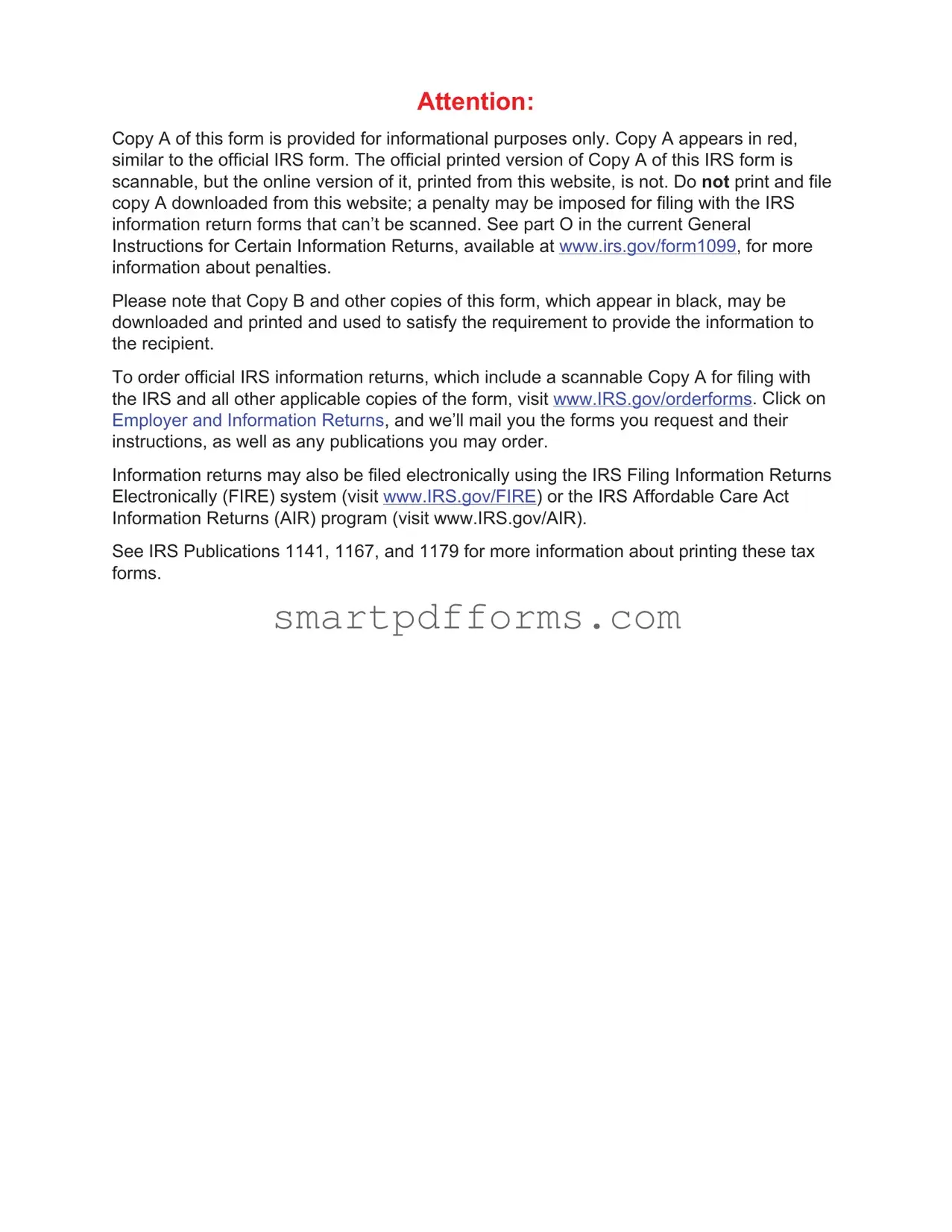Attention:
Copy A of this form is provided for informational purposes only. Copy A appears in red, similar to the official IRS form. The official printed version of Copy A of this IRS form is scannable, but the online version of it, printed from this website, is not. Do not print and file copy A downloaded from this website; a penalty may be imposed for filing with the IRS information return forms that can’t be scanned. See part O in the current General Instructions for Certain Information Returns, available at www.irs.gov/form1099, for more information about penalties.
Please note that Copy B and other copies of this form, which appear in black, may be downloaded and printed and used to satisfy the requirement to provide the information to the recipient.
To order official IRS information returns, which include a scannable Copy A for filing with the IRS and all other applicable copies of the form, visit www.IRS.gov/orderforms. Click on Employer and Information Returns, and we’ll mail you the forms you request and their instructions, as well as any publications you may order.
Information returns may also be filed electronically using the IRS Filing Information Returns Electronically (FIRE) system (visit www.IRS.gov/FIRE) or the IRS Affordable Care Act Information Returns (AIR) program (visit www.IRS.gov/AIR).
See IRS Publications 1141, 1167, and 1179 for more information about printing these tax forms.

TRANSFEROR’S name, street address, city or town, state or province, |
1 Date option granted |
OMB No. 1545-2129 |
|
Exercise of an |
country, and ZIP or foreign postal code |
|
Form 3921 |
|
|
|
|
|
Incentive Stock |
|
|
|
|
|
Option Under |
|
|
2 Date option exercised |
|
|
|
|
|
(Rev. October 2017) |
|
Section 422(b) |
|
|
|
|
|
|
|
|
|
|
|
TRANSFEROR’S TIN |
EMPLOYEE’S TIN |
3 Exercise price per share |
4 Fair market value per share |
Copy A |
|
|
|
on exercise date |
For |
|
|
|
|
|
EMPLOYEE’S name |
|
$ |
$ |
|
Internal Revenue |
|
|
|
|
|
Service Center |
|
|
5 No. of shares transferred |
|
|
|
|
|
|
|
|
|
|
|
|
File with Form 1096. |
Street address (including apt. no.) |
|
6 If other than TRANSFEROR, name, address, and TIN of |
For Privacy Act and |
|
Paperwork |
|
|
corporation whose stock is being transferred |
|
|
Reduction Act |
|
|
|
|
|
City or town, state or province, country, and ZIP or foreign postal code |
|
|
|
Notice, see the |
|
|
|
|
|
current version of |
|
|
|
|
|
the General |
Account number (see instructions) |
|
|
|
|
Instructions for |
|
|
|
|
|
Certain Information |
|
|
|
|
|
Returns. |
Form 3921 (Rev. October 2017) |
Cat. No. 41179O |
www.irs.gov/Form3921 |
Department of the Treasury - Internal Revenue Service |
Do Not Cut or Separate Forms on This Page — Do Not Cut or Separate Forms on This Page




